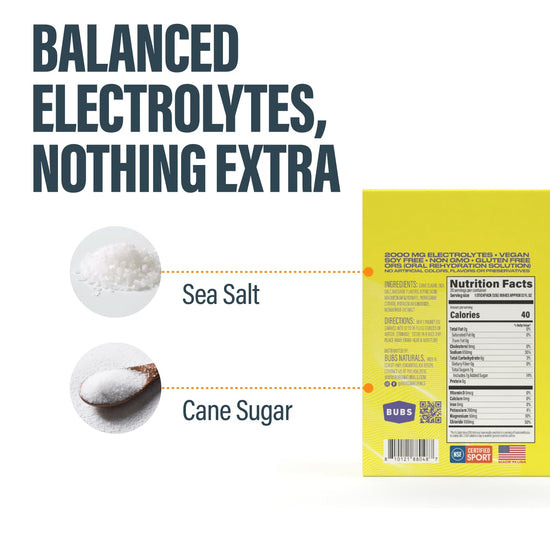Table of Contents
- Introduction
- What Are Electrolytes and Why Are They Important?
- The Mineral Profile of Celtic Salt
- The Potential Health Benefits of Using Celtic Salt
- How Celtic Salt Compares to Traditional Electrolyte Sources
- Practical Ways to Incorporate Celtic Salt into Your Diet
- Conclusion
- FAQ
When we think about hydration and maintaining our body's balance, the conversation often veers toward electrolytes and the various sources from which we can obtain them. Have you ever wondered whether Celtic salt, a popular choice among culinary enthusiasts and health-conscious individuals, can contribute to your electrolyte intake? Is it more than just a flavorful addition to our meals? In this post, we'll delve deep into the world of Celtic salt, examining its mineral composition, potential health benefits, and how it stacks up against more traditional sources of electrolytes.
Introduction
Salt has been a cornerstone of human nutrition and culinary practices for thousands of years. But not all salts are created equal. While refining processes have rendered many table salts devoid of essential minerals, Celtic salt emerges as a natural contender, celebrated for its unique flavor and mineral content. Originating from the coastal regions of Brittany, France, Celtic salt is harvested through traditional methods that preserve its natural properties, making it a sought-after ingredient in gourmet cooking.
Yet, with the rise of health trends and social media influencers touting various benefits, it's crucial to discern fact from fiction. Does Celtic salt genuinely provide the electrolytes our bodies need for optimal hydration and function? By the end of this article, you’ll gain a comprehensive understanding of Celtic salt, its mineral content, and whether it can effectively contribute to your electrolyte balance.
We will cover:
- What electrolytes are and their importance
- The mineral profile of Celtic salt
- The potential health benefits of using Celtic salt
- How Celtic salt compares to traditional electrolyte sources
- Practical ways to incorporate Celtic salt into your diet
So, let’s embark on this journey together to uncover the truth behind Celtic salt and its role in our health!
What Are Electrolytes and Why Are They Important?
Electrolytes are minerals that carry an electric charge, playing a vital role in various physiological functions. Key electrolytes include sodium, potassium, calcium, and magnesium, which help maintain hydration, muscle function, nerve signaling, and pH balance in the body.
An imbalance in electrolytes can lead to symptoms such as muscle cramps, fatigue, and irregular heartbeat—issues many of us may have experienced after a rigorous workout or during bouts of dehydration. To maintain optimal electrolyte levels, we often turn to sports drinks, supplements, and natural sources like fruits and vegetables. However, understanding how different salts, like Celtic salt, contribute to our electrolyte intake can provide additional options for those looking to enhance their diets.
The Mineral Profile of Celtic Salt
Celtic salt is known for its distinctive grey color, which comes from the minerals and clay present in the salt flats where it is harvested. Unlike refined table salt, which consists mainly of sodium chloride, Celtic salt retains a range of minerals that are beneficial for our health. Notably, it contains trace amounts of the following:
- Sodium: Essential for fluid balance and nerve function, but should be consumed in moderation.
- Magnesium: Important for muscle function, energy production, and regulating blood pressure.
- Calcium: Vital for bone health and muscle function.
- Potassium: Helps regulate fluid balance and is crucial for heart health.
Although Celtic salt does contain these minerals, it is primarily composed of sodium chloride, which means that while it does offer some additional benefits compared to regular table salt, the amounts of magnesium, calcium, and potassium are still relatively small.
The Potential Health Benefits of Using Celtic Salt
So, what health benefits can we glean from incorporating Celtic salt into our diets? Let’s explore the claims surrounding this mineral-rich salt and see what the research says.
1. Balancing Electrolytes
While it’s true that Celtic salt contains trace amounts of key electrolytes, it’s important to understand that these amounts are quite minimal. An analysis shows that Celtic salt typically comprises about 85% sodium chloride, with only about 0.5% attributed to the other minerals. Therefore, adding Celtic salt to your meals can provide a slight boost in these electrolytes, but it may not be sufficient for those needing substantial electrolyte replenishment, such as athletes or individuals dehydrated from illness.
2. Supporting Hydration
There’s a popular belief that adding salt to water can improve hydration by promoting water retention. While it’s true that electrolytes can help with hydration, the specific efficacy of Celtic salt in this regard lacks substantial scientific backing. Most hydration needs can be met through proper water intake, and for those engaged in intense physical activity, specialized electrolyte solutions may be more beneficial.
3. Enhancing Flavor and Culinary Experience
One of the most appreciated benefits of Celtic salt is its flavor profile. Many chefs and home cooks enjoy using it as a finishing salt to elevate the taste of dishes. The larger crystals provide a unique texture and burst of flavor that can enhance culinary experiences. Plus, the mineral content contributes a subtle complexity that can make healthy meals more enjoyable.
4. Skin Health and Exfoliation
Celtic salt is often used in bath products and scrubs. Some anecdotal evidence suggests that Celtic salt baths can soothe skin conditions like psoriasis or dry skin, thanks to its mineral content and exfoliating properties. While this does not directly relate to electrolyte balance, it’s a popular way individuals use Celtic salt for its potential skin benefits.
How Celtic Salt Compares to Traditional Electrolyte Sources
When considering hydration and electrolyte balance, it’s essential to compare Celtic salt to more conventional sources. Here’s a breakdown of how it stacks up against electrolyte powders and natural food sources:
| Source | Sodium | Potassium | Magnesium | Calcium |
|---|---|---|---|---|
| Celtic Salt | Moderate | Low | Low | Low |
| Electrolyte Powders | High | High | Moderate | Low |
| Fruits & Vegetables | Low | High | Moderate | Moderate |
As we can see, while Celtic salt adds flavor and some trace minerals, it does not provide the substantial electrolyte replenishment that dedicated electrolyte powders or whole foods can offer. For those engaged in regular exercise or facing dehydration, turning to a specialized electrolyte solution may be more effective.
Practical Ways to Incorporate Celtic Salt into Your Diet
If you’re looking to enjoy the benefits of Celtic salt while also enhancing your meals, consider the following suggestions:
- Use as a Finishing Salt: Sprinkle it on grilled meats or roasted vegetables just before serving for added flavor.
- Mix into Dressings: Add a pinch to salad dressings or marinades to enhance the taste.
- DIY Electrolyte Drink: Create a homemade electrolyte drink by mixing a small amount of Celtic salt with water, lemon juice, and a touch of honey or maple syrup for flavor.
- Bath Soaks: Utilize Celtic salt in your bath for a relaxing soak that may benefit your skin.
Conclusion
Celtic salt undoubtedly brings a unique flavor and a hint of minerals to our meals, but when it comes to providing essential electrolytes, it falls short compared to dedicated electrolyte sources and whole foods. While it can play a role in enhancing culinary experiences and offering trace minerals, relying solely on Celtic salt for hydration and electrolyte balance may not be sufficient for everyone.
As we strive for a life of adventure, wellness, and purpose—values that resonate with our mission at BUBS Naturals—it’s essential to ensure that our hydration strategies are backed by science and tailored to our unique needs. For optimal hydration and replenishment, consider complementing your diet with high-quality electrolyte solutions, such as our Hydrate Electrolytes, designed to support your active lifestyle and keep you feeling your best.
Explore the science-backed ingredients in our Hydrate Electrolytes collection and feel the BUBS difference!
FAQ
1. Can Celtic salt replace traditional electrolytes?
While Celtic salt contains trace amounts of electrolytes, it cannot replace traditional sources, particularly for those needing significant replenishment during intense physical activity.
2. How much Celtic salt should I use in my meals?
Celtic salt can be used sparingly as a finishing salt or seasoning. Just be mindful of your overall sodium intake, as too much sodium can lead to health issues.
3. Are there other natural sources of electrolytes?
Yes, fruits and vegetables—such as bananas, sweet potatoes, and spinach—are excellent sources of potassium and magnesium.
4. Can I use Celtic salt for hydration?
Adding small amounts of Celtic salt to water may marginally enhance hydration, but it should not replace the need for adequate water intake or specialized electrolyte drinks during intense activity.
Written by:
Bubs Naturals

Hydrate or Die
When you’re sweating hard—whether it’s from a tough workout, a long day in the sun, or just life—your body needs more than water to stay balanced and energized.
Hydrate or Die® delivers 2,000 mg of electrolytes in every serving to help you rehydrate faster, fight off fatigue, and keep going strong. That includes the right mix of sodium, potassium, and magnesium to support muscle function, prevent cramps, and maintain energy levels.
With a small dose of natural cane sugar to speed up absorption, this clean, easy-to-use powder is made for real performance—not just flavor.
Starts at $27.75
Shop

